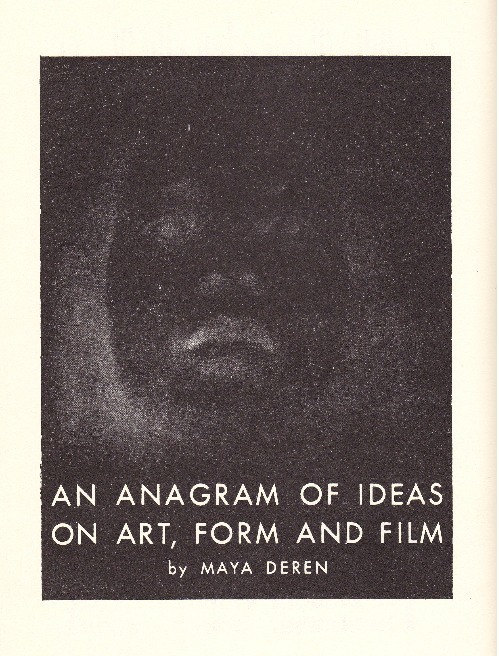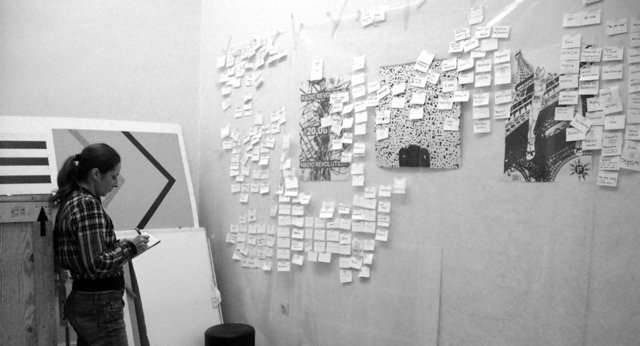Bureau for Open Culture: A Manual for the Immaterial Worker (2011)
Filed under pamphlet | Tags: · activism, art, immaterial labor, labour, precarity

This publication was commissioned by Printed Matter, Inc., a non-profit based in New York City that supports production and distribution of artist books. This book is part of Printed Matter’s Artists & Activists series. It looks at the historical and current conditions under which freelancers and information workers live.
Published by Printed Matter, Inc., New York City, July 2011
Artists & Activists series, No. 16
ISBN 9780894390586
16 pages
Copyright free
PDF
View online (Issuu)
Maya Deren: An Anagram of Ideas on Art, Form and Film (1946)
Filed under pamphlet | Tags: · art, experimental film, film, film theory

“Maya Deren’s four 16 mm. films have already won considerable acclaim. Convinced that there was poetry in the camera, she defied all commercial production conventions and started to make films with only ordinary amateur equipment. Her first, MESHES OF THE AFTERNOON (1943), was made with her husband Alexander Hammid, whose films–FORGOTTEN VILLAGE, CRISIS, HYMN OF THE NATIONS (Toscannini) and others–reveal also that devotion to the poetry of vision which formed the common ground of their collaboration. When other work claimed his time, Maya Deren went on by herself–conceiving, producing, directing, acting, (being unable to afford actors) photographing (when she was not in the scene) and cutting. Through all the trials of such shoe-string production, which included carrying equipment for miles to the location, she had only assistance of another woman, Hella Heyman, as camerawoman. Yet three more films were made: AT LAND, A STUDY IN CHOREOGRAPHY FOR CAMERA (with Talley Beatty) and RITUAL IN TRANSFIGURED TIME, thus proving that fine films could be made “for the price of the lipstick in a single Hollywood production.” Her heroic persistence has just been rewarded by a John Simon Guggenheim Memorial Foundation Fellowship. Moreover, the reputation of the films has spread so that performance at the Provincetown Playhouse were completely sold out and they have also been shown in colleges and museums throughout the country.
In this pamphlet Maya Deren’s approach to film reflects not the limited scope of a professional craftsman, but a broad cultural background–a profound interest not only in esthetics generally and in psychological insight, but in physics and the sciences as well. Russian-born, daughter of a psychiatrist, Maya Deren attended Syracuse University, when she first became interested in film, and received her B.A. from New York University and her M.A. from Smith College, both degrees in literature.” (Publisher’s Note)
Publisher Alicat Book Shop Press, Yonkers, New York, 1946
Issue 9 of “Outcast” series of chapbooks
52 pages
via meghedii
Experimental film at Monoskop wiki
Google books
PDF (no OCR; updated on 2012-7-14)
Comment (0)Anti-Jargon: Terms of Deschooling Classroom (2009-) [English, Serbian, Macedonian]
Filed under pamphlet | Tags: · art, art theory, contemporary art, education, self-education

“Terms is a group that studies terms in the field of contemporary artistic, theoretical, cultural and educational practice from the perspective of practitioners active on the independent cultural scenes of Skopje and Belgrade through the process of self-education. The aim of the group work was not to create yet another glossary, vocabulary or lexicon, but rather to establish a relational web of concepts in most frequent use. We either comprehend them differently or are, simply, unaware of the different readings according to one’s assumed theoretical (or ideological) position. Investigating the origin, epistemology and the politics of a term, we come to a non-implied, non-colloquial – anti-jargon term platform. By jargon we imply fast, specialized communication, with implied meaning but is actually completely empty. There is no implied meaning behind used terms, instead they only represent an affiliation to the moment, profession, ideology… This position is not a result of some kind of idealistic search for ‘authentic’, ‘original’ meaning of the word. On the contrary, it is a search to establish the term and the politicality of its use in the contextual, historically-materialistic sense. In addition, our intention is not only to detect and demonstrate the mechanism of jargon or to claim that we are excluded from it. The work on de-jargonisation we also view as affirmation of new terms. The new terms can be subjected to de-jargnisation as a prevention.
In this publication we offer the registry as a format for de-jargonisation – it is a simple table that is also one of the algorithms for using this publication. Origin, history, utilization, references and ‘description’ are determined for terms used in this table. ‘Description’ can be a note, artistic statement, a list of other terms, or something close to a lexicon entry. The entries in the table link to texts in the publication and outside of it – and thus create relational network of terms and definitions, virtually unlimited hypertextual structure. Publication is open in content and structure, and its real purpose is achieved if the users – editors/authors/readers – continue to work on it: filling in, adding, reediting and using it. That’s why we leave the registry unfinished, demonstrating the possible ways and formats of its use, and invite you to cooperate with is on making it grow.”
Terms: Artistic Immunity, Contexterin, Contextual art in the countries of Eastern Europe: Approaches, diagnoses and treatments of the problems, Festivals Classification, The Festivals (in the ex-Yugoslavia region) as a “microphysics of power” (Foucault), How my Life Turned into a Festival, Potentiality, Soros Realism
Working group: Milena Bogavac, Dragana Bulut, Bojan Đorđev, Anđela Ćirović, Siniša Ilić, Aleksandra Jančevska, Boris Krmov, Milan Marković, Katarina Popović, Biljana Tanurovska-Kjulavkovski, Ljiljana Tasić, Ivana Vaseva, Elena Veljanovska, Dragana Zarevska.
Comment (0)
